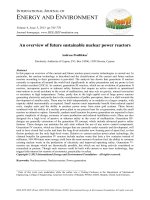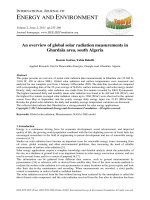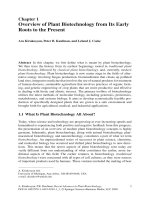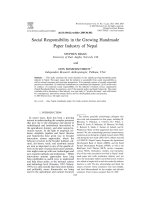Overview of Indian Paper Industry docx
Bạn đang xem bản rút gọn của tài liệu. Xem và tải ngay bản đầy đủ của tài liệu tại đây (238.83 KB, 47 trang )
Presented by
Dr. T. K. Roy
Director, CPPRI
Central Pulp & Paper Research Institute
Saharanpur, U.P., INDIA
Overview of
Indian Paper Industry
1
PAPER INDUSTRY AT A GLANCE
¾Total number of Pulp & Paper Mills 666
Wood Based 34
Agro Based 165
Recycled Fiber Based Mills 467
¾Pulp & Paper Mills in Operation 568
¾Pulp & Paper Mills Closed 98
¾Installed Capacity of Mills 6.9
million tonnes
¾Per-capita consumption 6.0 kg
(Paper & Paperboard)
¾Production 5.6 million tonnes – P&B
0.7 million tonnes - Newsprint
¾Turnover Rs. 16000 Crores
¾Exchequer Rs. 2500 Crores
¾Employment Direct-3 Lacs / Indirect-10 Lacs
The industry is fragmented with capacities ranging from 2 to 800 tonnes per day
2
GROWTH OF PAPER INDUSTRY
¾ In the 1970s excise concessions were given to small agro based mills, which resulted
in a rapid increase of small mills and capacity.
¾ In the late 1980s the industry was in a severe oversupply situation, capacity utilisation
rates being around 60 %.
¾ In early 1990s the government reversed the policy, making large units more
competitive (e.g. by removing excise concessions for agro based mills).
¾ First mill in the country was commissioned in 1812 in Serampur (W. Bengal).
¾ The initial development & growth of industry in the 19
th
century was affected by
shortage of wood (soft wood) in the country.
¾ In 1914 the development of pulp making processes based on bamboo lead to
rapid growth of the industry and by the end of the 1950’s installed capacity increased
to 137000 tonnes.
3
GROWTH OF PAPER INDUSTRY … Contd…
Paper capacity and production in India 1950-2005
0.00
2.00
4.00
6.00
8.00
1950 1960 1970 1980 1990 2000 2005
Capacity
Production
Million tonnes
Nearly 1.25 million tones of capacity is closed
¾ Technological obsolescence
¾ Environmental issues
Reasons for Closed Capacities
5
Other
varities
5%
Industrial
paper
55%
Writing &
printing
grades
40%
Writing & printing grades
Industrial paper
Other varities
Total Paper and Paperboard demand in India
CAGR of nearly 5.5%
in the past 3 years.
6
Year Production Imports Exports Consumption
1995-96 3.81 0.42 0.09 4.14
1996-97 4.11 0.59 0.07 4.63
1997-98 4.58 0.65 0.06 5.17
1998-99 4.81 0.56 0.06 5.30
1999-00 5.5 0.55 0.10 6.1
2000-01 5.5 0.56 0.13 6.02
2001-02 5.57 0.56 0.29 5.98
2002-03 5.87 0.69 0.23 6.33
2003-04 6.24 1.01 0.23 7.0
2004-05 6.52 0.87 0.26 7.15
All figures in Million Tonnes
Paper, Paperboard & Newsprint
7
STRUCTURE OF PAPER INDUSTRY
34
165
467
0
100
200
300
400
500
Wood Based
Mills
Non Wood
Based Mills
RCF Based Mills
Categorization of the Mills Based on Cellulosic
Raw Materials
Number of Mills
8
PER CAPITA CONSUMPTION
The per capita paper consumption in India is 6 kg compared to 324 kg in USA, 25 kg in
Indonesia, 250 kg in Japan and 37 kg in China
0
50
100
150
200
250
300
350
P
A
K
I
S
T
A
N
INDI
A
L
ATI N
A
ME RI
CA
EASTE
R
N
E
U
R
O
PE
IN
D
ON
E
S
I
A
CH IN
A
WOR L D
(
A
v
era
ge
WE
STE
R
N
E
U
R
O
P
E
JAPA
N
NORTH AMERI
CA
Per Capita Consumption
Kg
9
FIBRE RESOURCES
India is a fibre deficient country. Due to lack of wood resources, the paper industry is
utilizing a wide verities of raw material for paper making ranging from forest based raw
material to annual plant and recovered paper.
Forest based Agro based Recycled fiber
7%
9%
84%
39%
31%
30%
34%
28%
38%
1970
2000
2005
10
TECHNOLOGICAL STATUS
¾ Obsolescence of technology in most cases.
¾ Lack of eco friendly state of the art processing technologies.
¾ Uneconomic scale of operation.
¾ In an international comparison, even the largest machines are medium-size
− The average capacity of paper machines is about 14000 t/a
− Most of Indian paper machines have a trim width from 1.5 to 3.5 m
− There are only 9 paper machines with trim width of 5 m or more
− Only 14 machines have capacities 50000 t/a or more
¾ It is not possible to have very high speed paper machine, i.e. >1500 mpm for
type of raw material available in India
¾ Similarly for adoption of new papermaking technology quality of raw material and
mill size are the major limitations.
¾ Except the wood based integrated mills and few agro/RCF mills the level of
automation and process control is very low in most of the mills
11
ENVIRONMENTAL COMPLIANCE - ISSUES
¾ (CREP) for Paper Industry was introduced in the year 2003 by MoEF
¾ (CREP) to be complied by entire industry between 2005 to 2008.
The major environmental issues :
¾ Control of color and AOX discharge
¾ Control of release of Non Condensable Gases (NCG’s).
¾ Disposal of Solid waste viz. Lime Sludge/Fly ash
12
Environmental issues Implementation Schedule (from April
2003)
Discharge of AOX kg/ t
paper
AOX 1.5 kg/ t
paper
within 2 years
AOX 1.0 kg/ t
paper
in 5 years
Installation of Lime Kiln Within 4 years
Waste water discharge m
3
/ t
paper
< 140 m
3
/ t
paper
within 2 years
< 120 m
3
/ t
paper
within 4 years for units installed
before 1992
< 100 m
3
/ t
paper
for units installed after 1992
Odor Control by burning the reduced sulfur
emissions in the boiler / lime kiln
Installation of odor control system within 4
years
Utilization of treated effluent for irrigation Wherever possible
Color Removal from the effluent IPMA to take up project with CPPRI
CREP – LARGE MILLS
13
Environmental Issues Implementation Schedule (from
April 2003)
Compliance of standard of BOD, COD &
AOX
Either achieve the discharge Standards
of BOD, COD & AOX by installation of
chemical recovery system or utilization
of black liquor with no discharge from
pulp mill within 3 years or
shift to waste paper
Up-gradation of ETPs so as to meet
discharge standards
Upgrade the ETP within one year so as to
achieve the discharge standards
Waste water discharge/ tonne of paper < 150 m
3
/ t
paper
within 3 years
Utilization of treated effluent for
irrigation
Wherever possible
Color Removal from the effluent IPMA to take up project with CPPRI
CREP – SMALL MILLS
14
ISSUES BEFORE INDIAN PAPER INDUSTRY
Low scale of operation
Inferior pulp & paper quality
High cost of transportation and power
Low capacity utilisation
High capital costs
High costs of raw materials
Issues &
Challenges
O
n
l
y
20
%
o
f
th
e
total
u
s
e
d
p
ap
e
r
i
s
r
e
c
yc
l
e
d
i
n
I
n
d
i
a
c
om
p
ar
e
d
to
a
gl
ob
al
r
e
c
y
c
l
i
n
g
ave
r
age
of
40%
State of art equipment &
machineries
Emerging Environmental issues
DEMAND & SUPPLY SCENARIO
16
Source - Financial Express,19 Feb 2006
6.24
5.75
0.49
8.33
6.79
1.54
11.1
8.01
3.09
14.85
9.46
5.39
0
2
4
6
8
10
12
14
16
Paper Million Tonne
1
Year
Demand Supply Shortfall
2005 2010 2015 2020
Demand Growth @ 6%/annum
Supply Growth @ 3.4%/annum
Paper Million Tonne
Source – Jaakko Poyry Report 2002
Projected Demand, Supply and Short fall of Paper & Paperboard
4.9
4.5
0.4
6.7
6.1
0.6
9.1
8.5
0.6
12.2
10.9
1.3
0.0
2.0
4.0
6.0
8.0
10.0
12.0
14.0
2005 2010 2015 2020
Demand Supply Shortfall
Year
Paper Million Tonne
17
0.00 2.00 4.00 6.00 8.00 10.00 12.00 14.00 16.00
Supply
Demand
Supply
Demand
Supply
Demand
Supply
Demand
2005 2010 2015 2020
Industrial Cultural Others
pp
0.00 2.00 4.00 6.00 8.00 10.00 12.00 14.00 16.00
Supply
Demand
Supply
Demand
Supply
Demand
Supply
Demand
2005 2010 2015 2020
Industry Cultural Others
Source - Financial Express, 19 Feb 2006
Source – Jaakko Poyry Report 2002
Paper Million Tonnes
Paper Million Tonnes
Projected Demand & Supply of Various Grades of Paper & Paperboard
18
1.62
0.73
0.89
2.16
0.86
1.30
2.90
1.02
1.88
3.88
1.20
2.68
0.00
0.50
1.00
1.50
2.00
2.50
3.00
3.50
4.00
2005 2010 2015 2020
Demand Supply Shortfall
1.20
0.73
0.47
1.60
1.00
0.60
1.90
1.40
0.50
2.40
1.80
0.60
0.00
0.50
1.00
1.50
2.00
2.50
2005 2010 2015 2020
Demand Supply Shortfall
Source - Financial Express, 19 Feb 2006
Newsprint Million Tonnes
Source – Jaakko Poyry Report 2002
Newsprint Million Tonnes
Projected Demand & Supply Shortfall of Newsprint
19
CELLULOSIC RAW MATERIALS - FUTURE TRENDS
2005
84%
2010
Recycled Fiber
Production – 6.5 Million Tonnes Demand Projected - 8.3 Million Tonnes
38%
28%
34%
Agro based
40%
28%
32%
Wood based
20
INDUSTRIAL WOOD DEMAND SCENARIO
0
2
4
6
8
10
12
14
2005 2010 2015
Million tonness of wood
Depends on agro/ waste paper use
The paper industry’s wood demand is expected to grow from 5.9 million tonness to 7.9
million tonness by 2010, and to over 10.6 million tonness by 2015.
~0.6 million hectares and 0.8 million hectares of land will be required by 2010 and 2020
respectively to meet paper industries wood demand.
5.9
7.9
10.6
21
AVAILABILITY OF AGRICULTURAL RESIDUES
Since 1970 agricultural residues have emerged as significant alternate raw material with
total fiber use share being 29%.
The main agricultural residues utilized by the paper industry include bagasse, straws
(wheat and rice) and grasses.
Availability of agricultural residues is good, but there are many limitations to their use
7
4
44
0
5
10
15
20
25
30
35
40
45
A
g
ro Residue 2003 2010
Availability
Requirement by Paper Industry
M
illio
n
T
o
n
n
es
22
RECYCLED FIBRE - RECOVERY & RECYCLING
Million tons
0
2
4
6
8
1995 2000 2003 2010
Recovery Imports Consumption
¾ Import of waste paper is continuously increasing
¾ At present more than 80% of consumption is met through imports.
INDIAN PAPER INDUSTRY IN GLOBAL
PERSPECTIVES
24
0 20000 40000 60000 80000 100000 120000
Venezuela
Chile
Colambia
Argentina
South Africa
Australia
Thailand
Mexico
India
Taiwan
United Kingdom
Rus sia
Brazil
Indonesia
Sweeden
Kor ea
France
Finland
Germany
Canada
Japan
China
US
Paper & Board Capacity (2000)
‘000 tonnes
India is among the top fifteen global producers
Source : ICRA report to IPMA : 2000
INDIAN PAPER INDUSTRY IN GLOBAL PERSPECTIVES
INDIA









